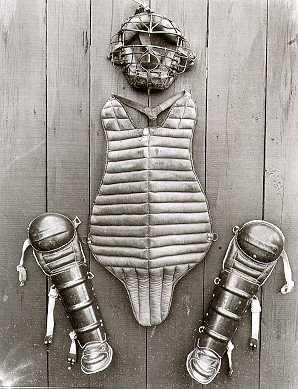|
| ||||||
|
| ||||||
| HISTORY | MITTS | MASKS | SHIN GUARDS | CHEST | MISC | SIZING |
|
| ||||||
|
|
|
 |
 |
| Two warriors dressed for survival for the game's toughest position. At left is Roger Bresnahan (1907) and right is Ivan "Pudge" Rodriguez (1999) | |
The field position denoted in the scorebooks as "2" has never been an easy job. Errant balls, foul tips and flying bats are all a source of pain for catchers. Collisions at the plate occur with regularity, some more painful than others. No protection short of a bunker could have spared 23-year-old Ray Fosse the career-shortening injury he sustained in the 1970 All-Star Game. Catcher-turned-announcer Tim McCarver says he still suffers from nerve damage in his neck cased by back-to-back plate collisions a quarter of a century ago. Today, catchers often put their bodies literally on the line, most often the one on the third-base side.
Baseball, though it sometimes seems the most tradition-bound of sports, has always shown that All-American penchant for tinkering and innovation. This quest for the better mousetrap has been amply applied to catcher's gear. The evolution of the equipment corresponds to actual changes in the tactics and rules of the game. The tinkering continues. This season a new "digital" catcher's mitt, designed to soften the ball's impact and reduce errors, makes its debut.
Catchers are expected to take their lumps without grumbling. But the early efforts of catchers to protect themselves met with a lot of flak. A typical reaction came from the crowd at the Polo Grounds when baseball's New York Giants opened the 1907 season against the Philadelphia Phillies. As the Giants took the field, star catcher Roger Bresnahan looked more like a goaltender than a backstop when he squatted behind the plate in a pair of thickly upholstered shin guards.
It was the first time a catcher had dared to don the protective gear in open view and the crowd's reaction came as quick as a foul tip and just as nasty.
"Spectators howled with delight when a foul tip in the fifth inning rapped the protectors sharply," reported The New York Times. Bresnahan, more concerned about his livelihood than remarks about his manliness, ignored the insults from fans and foes.
Bresnahan's shin guards were the final pieces of the catcher's armor, following the glove, mask and chest protector. This kit was lovingly dubbed "the tools of ignorance" by Herold "Muddy" Ruel, a lawyer turned backstop who caught for greats like Walter Johnson with the Washington Senators in the 1920s. Ruel probably would have stayed a mouthpiece if he'd caught in the late 1860s. The first piece of protection for catchers, a rubber mouth protector, dates to that era, purloined perhaps from the sport of bareknuckles boxing.
Backstops began crowding the plate in 1880 when a rules change dictated that the final strike, including foul tips, had to be caught on a fly for a putout. Pitchers had begun throwing overhand by the mid-1880s, and the mound was moved progressively farther from home plate until it reached its current 60 ft. 6 in. in 1893. To better frame the pitches, field bunts and throw out base-stealers, some catchers had begun inching closer to the plate as early as 1875.
 A page from the Victor Sporting Goods Company shows that one of baseball's first concerns of the 20th C. was to develop practical catching equipment. |
 Typical catching equipment, circa 1942. |
Catching has never appeared to be an easy or cushy job. Even with protective accessories, the position seems to lead the league in injuries yearly. That's why safety and productivity have been the goals of a variety of catching inventions throughout the history of the game.
For more detailed information about the history of each piece of catching equipment, go back to the top of this page and click on the "Tools of Ignorance" of your choice.
